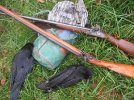Snakeoil
Well-Known Member
I think this is the best thread ever to appear here! No offense intended to others.
Looking at the muzzle before pics, it appears there are some brass or gold toned areas. Are they truly there or is that just lighting in the photos?
Your ability to hide the repairs is quite remarkable. I've done similar, but not on something old like this. And not using any of the unique techniques that you are using. Just finding the replacement wood from the correct period is quite amazing to me. This thread will be my inspiration to make an invisible repair the next time the opportunity presents itself. Thanks again for sharing this.
Looking at the muzzle before pics, it appears there are some brass or gold toned areas. Are they truly there or is that just lighting in the photos?
Your ability to hide the repairs is quite remarkable. I've done similar, but not on something old like this. And not using any of the unique techniques that you are using. Just finding the replacement wood from the correct period is quite amazing to me. This thread will be my inspiration to make an invisible repair the next time the opportunity presents itself. Thanks again for sharing this.


